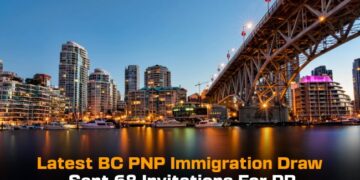Are you dreaming of a fresh start or new opportunities in the wonderfully diverse country of Canada? Whether you want to study, work, or take an extended vacation to soak up the rich Canadian culture, your first step is to get temporary residency in Canada. This guide is here to make the process simple for you. We’ll provide detailed yet easy-to-understand information, so you can confidently embark on your Canadian adventure!
Understanding the Concept of Temporary Residency in Canada
The concept of ‘temporary residency in Canada’ can be understood as a provision that allows non-Canadians to reside in the country for a predetermined period, usually up to six months. This status is broken down into three key categories: visitors, students, and workers. Each category has its special benefits and comes with its own set of responsibilities.
Visitors are individuals who enter Canada for leisure or business-related activities, while workers are those who are in the country for job opportunities. They typically require a work permit. On the other hand, students are individuals who move to Canada with the intent of pursuing their studies, usually holding a study permit.
What is Temporary Resident Visa?
A ‘Temporary Resident Visa’ (TRV) is a crucial document that permits you to enter Canada. However, one should not confuse it with a ‘temporary resident permit’ or a ‘temporary resident status’. They are different from each other. The TRV is purely an entry document, whereas the permit and status pertain to your allowances and activities once you are in the country.
Canadian Permanent Residence: Everything You Need to Know
Understanding Different Types of Temporary Resident Permits
- Visitor Permit: For those visiting Canada for vacationing, business dealings, or visiting family, this permit is required. Typically, it allows you to stay for up to six months in the country.
- Work Permit: This permit allows you to legally work in Canada. It’s usually associated with a specific employer and job role.
- Study Permit: This permit allows you to study at a designated learning institution in Canada. The duration of the permit coincides with the length of your course, plus an extra 90 days to prepare for departure or extend your stay.
- Study in Canada: Your Ultimate Guide as an International Student
- Post-Graduation Work Permit (PGWP) in Canada
Step-by-Step Guide to Apply for Temporary Residency in Canada
Applying for ‘temporary residence in Canada’ is an accessible process if you follow the steps below:
- Check Your Eligibility: You need to fulfil certain requirements for your desired category – visitor, worker, or student. This includes your health status, financial capacity, etc.
- Gather Your Documents: Keep your essential documents ready. These include identification proofs, evidence of financial capability, a record of your travel history, etc.
- Application Submission: You can submit your application electronically to Immigration, Refugees and Citizenship Canada (IRCC), or at a Visa Application Centre outside Canada.
- Payment of Application Fees: The cost of your application will vary based on your category. For instance, a visitor visa application costs CAD 200.
- Waiting for Processing: The processing time differs depending on the type of application and the method of submission.
How to Extend Your Stay as a Temporary Resident?
If you find yourself enchanted by Canada and want to extend your stay, ensure you apply for an extension before your current ‘temporary resident status’ expires. This process can be accomplished online via the IRCC website.
Determining Eligibility for Temporary Residency
Whether you can stay in Canada temporarily depends on different things. They look at whether you plan to leave Canada after your allowed time if you have enough money to support yourself while you’re here, and how connected you are to your home country. Each type of stay (as a visitor, worker, or student) has its own rules for who can come.
Essential Documents for Your Application:
The documents you need will depend on your chosen category. Generally, these include proof of identification, evidence of financial resources, invitation letters (for visitors), or employment/study offers (for workers and students), among others.
How to Handle Application Refusals?
In case your application is denied, don’t lose heart. You can either appeal the decision or re-apply. If you choose to re-apply, make sure to address the reasons for refusal in your new application to improve your chances of approval.
Transitioning from Temporary to Permanent Residency:
If you have long-term plans in Canada, your temporary stay can become a stepping stone toward acquiring permanent residency. Several programs like the Canadian Experience Class, Federal Skilled Worker Program, and various Provincial Nominee Programs can aid in this transition.
Conclusion:
Getting temporary residency in Canada may seem challenging, but with the right information, it’s something you can achieve. Remember, the journey is just as exciting as the destination itself. Whether you’re aiming for a Visitor, Work, or Study Permit, understanding the process and requirements is your key to success.
And remember, your temporary stay could even be a pathway to permanent residency. As always, for the most accurate and up-to-date information, be sure to check the official IRCC website. We wish you the best of luck on your journey toward making Canada your new temporary home!
Frequently Asked Questions:
Q1: What’s the difference between a Temporary Resident Visa and a Temporary Residency?
A Temporary Resident Visa (TRV) is a document that allows you to enter Canada as a visitor. It is usually a stamp or sticker placed on your passport. On the other hand, Temporary Residency refers to the status of being allowed to stay in Canada for a specific period, whether as a visitor, worker, or student. So, the TRV is the permission to enter, while temporary residency in Canada is the permission to stay.
Q2: Can I work in Canada with a visitor status?
Generally, visitors can’t work in Canada without a work permit. Exceptions are rare and specific, like for business visitors or performing artists. If you plan to work, you’ll likely need a work permit.
Q3: Can a temporary resident apply for a work permit?
Yes, temporary residents often can apply for work permits. Make sure to check the eligibility criteria for your category. For instance, students with valid study permits can sometimes get work permits.
Q4: Will a refused Temporary Residency application affect my future applications?
A refused Temporary Residency application could affect future ones, as immigration officers look at past applications. However, it doesn’t disqualify you. Understand why you were refused and address these issues in future applications.
Q5: How can I extend my stay in Canada as a Temporary Resident?
If you wish to extend your stay in Canada, you must apply for an extension before your current temporary resident status expires. You can apply for this extension online via the IRCC website.
Q6: What are the different types of Temporary Resident Permits in Canada?
Canada offers three types of Temporary Resident Permits: Visitor Permit (for vacationing or business dealings), Work Permit (to legally work in the country), and Study Permit (to study at a designated learning institution). The duration and restrictions of these permits vary based on the specific type.
Related Articles in Newcomer Resources:














